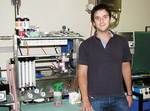Chronic sinus research reveals sheep link
 Research Research
It's well known that humans have much in common with apes, but less well appreciated that when it comes to our sinonasal anatomy we are pretty close to sheep. That may not sound much to boast about, but it has helped University of Adelaide PhD candidate Dr Alkis Psaltis make an important discovery about Rhinosinusitis, a debilitating condition that affects up to 14% of people in the Western world. In turn, that research has won Dr Psaltis two major awards: the Maurice H. Cottle Honour Award from the American Rhinologic Society (shared with co-researcher and University of Adelaide masters student Dr Kien Ha) and the Sir Edward Hughes Memorial Clinical Research Award in surgery from Monash University. Both awards are prestigious, and the latter was also historic - it has never before been won for research outside the field of general surgery or by a South Australian. "It really was a great honour," Dr Psaltis said. Rhinosinusitis can be relatively tame. Most of us have experienced what we think of as a head cold, which usually passes within a week. However, more than one person in 10 people suffers from chronic rhinosinusitis, which can require multiple courses of antibiotics and even surgery. Symptoms such as nasal discharge, facial pain and headaches can plague them for months each year. Dr Psaltis' research set out to investigate if, and if so how, bacterial biofilms are linked to the development of chronic rhinosinusitis. Biofilms themselves are an interesting story. In the 1880s a Dutch lens maker discovered that bacteria do not always exist in the then well-known, free-floating form which is easy to investigate under a microscope. In fact, in 99% of cases bacterial cells encase themselves in a protective matrix and attach themselves to whatever they want to attack (dental plaque is a good example). Their genetic profile changes when they do so, and this helps make biofilms very hard to identify and extremely difficult to treat. The medical community largely ignored this discovery until about 20 years ago, but since then has linked biofilms with everything from medical equipment to conditions such as cystic fibrosis and chronic tonsillitis. Previous research also has suggested that biofilms are present in as many as 90% of chronic rhinosinusitis cases, but Dr Psaltis' findings suggest otherwise. First working with sheep, then humans, he found a link in only 50% of cases, but a strong link where people suffer very bad long-term effects. A key to his findings was access to the University of Adelaide's state-of-the-art Confocal Scanning Laser Microscope, which provides significantly more accurate results than standard electron microscopes. "We have not yet established a direct causal relationship linking biofilms to chronic rhinosinusits, but there is strong evidence that in the very least they cause it to persist and become a significant problem," he said. "Some people never really recover." Dr Psaltis' findings will be published in several US academic journals this year and he has been invited to address the American Rhinologic Society again in September. Much of the research, under the supervision of Professor Peter-John Wormald, has been carried out at the Queen Elizabeth Hospital where Dr Psaltis is also an ear, nose and throat registrar. His next project - again starting with sheep - is to try to treat or remove biofilms, either mechanically or by dissolving them in solution. Initial in vitro trials with both options are promising. Story by Nick Carne
|





